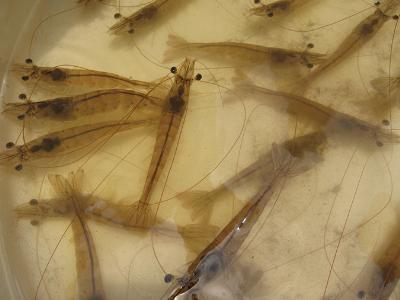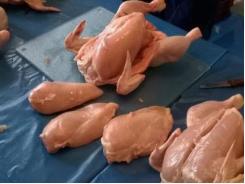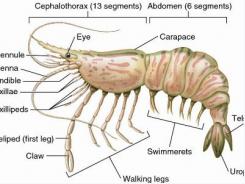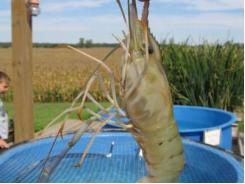The digestibility of hydrolyzed soy protein

Alternative feed ingredient promotes growth and immune responses in Pacific white shrimp
Hydrolyzed soy protein is well digested and utilized by Pacific white shrimp, and can enhance growth and immune responses. Photo by Darryl Jory.
The Pacific white shrimp (Litopenaeus vannamei) is the most important cultured shrimp species in the world. In addition to having fast growth rates and other desirable characteristics for culture, this shrimp species can well utilize higher inclusion levels of plant ingredients relative to other farmed shrimp species, such as the Kuruma shrimp or the black tiger shrimp.
Fishmeal has a high-nutritional value but its cost can be very high and vary in supply over time, and its availability may decline and prices increase in the future. Other less expensive and more readily produced protein sources are needed for the manufacture of shrimp and all aquafeeds. Soybean meal is the most widely used plant ingredient in the aquafeed industry. However, it has some limitation, including its deficient levels of methionine and lysine, and the presence of anti-nutritional factors such as trypsin inhibitors, hemagglutinin, phytic acid, saponin, phytoestrogens and others.
In Asia, the quality of soybean meal is traditionally improved through bioprocessing by using microorganisms, including Lactobacillus spp., Bacillus spp., Aspergillus spp. and others. Bioprocessed soybean meal has decreased anti-nutritional factors and protein molecular weight, and increased levels of organic acids and small peptides.
In a previous study, we showed that bioprocessed (hydrolyzed) soybean meal protein can be used as an alternative protein source in grouper and barramundi diets. Hydrolyzed soy protein can replace 30 percent of fishmeal in grouper diets without any negative effects on fish growth, and groupers fed diets with fishmeal replaced by hydrolyzed soy protein at 20 to 40 percent showed higher immune responses than fish fed diets with other fishmeal inclusion levels. Similar results were found for barramundi, with fish fed a diet with 20 to 30 percent replacement of fishmeal by hydrolyzed soy protein showed higher immune responses than fish fed diets with other fishmeal inclusion levels.
Here we present the results of two studies to evaluate the use of hydrolyzed soy protein substituting fishmeal in diets for Pacific white shrimp. In the first experiment, the digestibility of hydrolyzed soy protein compared with fishmeal and soybean meal were determined. In the second experiment, we measured the effects of replacement levels of fishmeal by hydrolyzed soy protein on shrimp growth and immune responses.
Digestibility of soybean meal and hydrolyzed soy protein
The formulation of reference and test diets for Pacific white shrimp is included in Table 1. The test diet contained 70 percent of the reference diet and 30 percent test ingredients, including brown fishmeal from a commercial supplier in Peru, soybean meal from a commercial supplier in Taiwan, and hydrolyzed soy protein (Lactobacillus spp. – fermented soybean meal from a commercial supplier, DaBomb Protein, in Taiwan). Both reference and test diets were supplemented with 0.5 percent chromium oxide as an inert indicator. Reference and test diets were hand-made in our lab at the National Pingtung University of Science and Technology (Pingtung, Taiwan).
Yu-Hung Lin, Table 1

Formulation of reference and test diets.
The juvenile shrimp used in this study were procured at a local hatchery (Pingtung, Taiwan). At the beginning of the experiment, 25 shrimp (mean weight: 3.93 ± 0.12 g) were stocked in each experimental tank (300 L FRP). Each experimental diet was fed to three groups of shrimp. Each tank was part of a closed-recirculating system with seawater. A photoperiod of 12 hours light (0800-2000h), 12 hours dark was used. Water temperature of the rearing system was 28±1°C. Shrimp were fed 6 percent of their body weight per day. The daily ration was divided into two equal meals (09:00 and 17:00 h). After the first feeding, the uneaten feed and fecal residues were removed and the feces were collected at 11:00, 12:00, 13:00, 14:00 and 15:00 by a feces collection column. Feed and feces were analyzed the proximate composition by the AOAC method and chromium (Cr) concentration using an atomic absorption spectrophotometer.

Experimental tanks and the recirculating system used in the study; each tank was set-up with a feces collection column.
For soybean meal and hydrolyzed soy protein, we determined the distribution of molecular weight of protein by HPLC. The calculation of apparent digestibility coefficient (ADC) was shown as below:
- ADC-DM (PERCENT) = 100 × (PERCENT CR IN FEED / PERCENT CR IN FECES)
- ADC-CP (PERCENT) = 100 × [1- (PERCENT CR IN FEED / PERCENT CR IN FECES) × (PERCENT CP IN FECES / PERCENT CP IN FEED)]
- ADCI=ADCT + [(0.7 × NR) / (0.3 ×NT)] × (ADCT – ADCR)
- WITH DM: DRY MATTER; CP: CRUDE PROTEIN; I: TEST INGREDIENT; T: TEST DIET; R: REFERENCE DIET; N: NUTRIENT COMPOSITION
The results showed that ADC-DM was higher (P<0.05) in fishmeal (72.26 percent) and hydrolysis soy protein (73.05 percent) than that in soybean meal (64.79 percent). The ADC-CP was the highest in fishmeal (86.78 percent), followed by hydrolysis soy protein (84.23 percent) and lowest in soybean meal (80.44 percent).
Fig. 1A shows the molecular weight of soybean protein majorly distributed at 30 – 70 kDa (66.7 percent). Results clearly indicate that, after bioprocessing by Lactobacillus spp., the molecular weight of hydrolyzed soy protein was majorly distributed at ≤ 30 kDa (75.39 percent) (Fig 1B). Hence, a higher digestibility of hydrolyzed soy protein over soybean meal is expected. We concluded that apparent dry matter and crude protein digestibility of soy protein for Pacific white shrimp can be improved through bioprocessing with Lactobacillus spp.

Fig. 1: The distribution of molecular weight of protein: (a) soybean meal; (b) hydrolyzed soy protein.
Effects of substitution of hydrolyzed soy protein to fishmeal
In the second experiment, we conducted an 8-week growth trial to evaluate the effect of substitution of fishmeal protein by hydrolyzed soy protein in diets on growth and immune responses of Pacific white shrimp. Brown fishmeal was replaced by hydrolyzed soy protein at 0, 5, 7.5, 10, 15 and 20 percent as protein percentage.
Shrimp with an initial weight of 8.5 grams were reared in an outdoor, 10,000-liter cement pond at a density of 360 shrimp. Shrimp were under natural photoperiod and water temperature was 25 to 27.8 degrees-C. Shrimp were fed 4 percent of their body weight per day, and the daily ration was divided into two equal meals (09:00 and 17:00 h).
Weight gain and feed conversion ratio (FCR) were measured as growth parameters. For evaluation of immune responses, total haemocyte count, phenoloxidase, respiratory burst, superoxide dismutase activity and survival rate after challenge test of Vibrio alginolyticus were determined.
Weight gain and FCR were not affected (P<0.05) by the dietary treatments. These results indicated that fishmeal replaced by hydrolysis soy protein did not cause negative effects on growth performance, suggesting hydrolysis soy protein can substitute fishmeal by at least 20 percent in a white shrimp diet.
Total haemocyte count was higher (P<0.05) in animals fed the diet with 5-10 percent replacement of fishmeal by hydrolyzed soy protein vs. the all fishmeal diet (0 percent replacement) Shrimp fed the diet with 7.5 to 15 percent substitution of fishmeal by hydrolyzed soy protein had higher haemolymph superoxide dismutase activity than shrimp fed diets with 0 and 20 percent substitution.
After shrimp were infected with the pathogenic Vibrio alginolyticus, results showed that the groups fed the diet with 5 to 15 percent replacement of fishmeal by hydrolysis soy protein had higher survival rates than those animals on the diets with 0 and 20 percent replacement (Fig. 2).

Fig. 2. The various responses of white shrimp fed different diets for 8 weeks during study.
In this experiment, supplementation of hydrolyzed soy protein in the white shrimp diet appeared to show a positive effect on immune responses. This might possibly be due to the additional function of the hydrolysates (small peptides) of soy protein, which has been observed in other farmed species like Atlantic salmon and Japanese flounder.
In the 20 percent substitution ratio group, the immune responses of shrimp were decreased. This might be due to imbalanced nutrition, such as limiting amino acids, or residual presence of anti-nutritional factors. But an appropriate ratio of hydrolyzed soy protein partially substituting fishmeal appears to enhance immunity of Pacific white shrimp. Based on observed growth performance, we concluded that hydrolyzed soy protein at 20 percent substitution of fishmeal protein is appropriate. In addition, the recommended substituted level for hydrolyzed soy protein to enhance immune responses of white shrimp is 15 percent.
Perspectives
In our study, we demonstrated that hydrolyzed soy protein can be well digested and utilized by white shrimp, and that the digestibility of soy protein is improved through bioprocessing with Lactobacillus spp. We also demonstrated that hydrolyzed soy protein is a potential alternative protein source for white shrimp. The recommended substitution levels of this protein source to fishmeal protein are 20 percent and 15 percent for growth performance and immune responses, respectively.
References available from authors
Dr. Yu-Hung Lin
- Department of Aquaculture
- National Pingtung University of Science and Technology,
- Pingtung, Taiwan ROC
Kevin Liu
- DaBomb Protein Corporation
- Tainan, Taiwan ROC
Related news
Tools

Phối trộn thức ăn chăn nuôi

Pha dung dịch thủy canh

Định mức cho tôm ăn

Phối trộn phân bón NPK

Xác định tỷ lệ tôm sống

Chuyển đổi đơn vị phân bón

Xác định công suất sục khí

Chuyển đổi đơn vị tôm

Tính diện tích nhà kính

Tính thể tích ao




 Twin screw technology for better extruded feeds
Twin screw technology for better extruded feeds  Determining safe levels of ammonia and nitrite for…
Determining safe levels of ammonia and nitrite for…